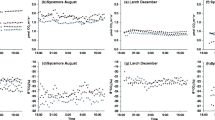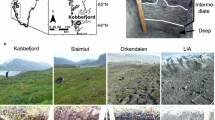Abstract
Temperate forests of North America are thought to besignificant sinks of atmospheric CO2. Wedeveloped a below-ground carbon (C) budget forwell-drained soils in Harvard Forest Massachusetts, anecosystem that is storing C. Measurements of carbonand radiocarbon (14C) inventory were used todetermine the turnover time and maximum rate ofCO2 production from heterotrophic respiration ofthree fractions of soil organic matter (SOM):recognizable litter fragments (L), humified lowdensity material (H), and high density ormineral-associated organic matter (M). Turnover timesin all fractions increased with soil depth and were2–5 years for recognizable leaf litter, 5–10 years forroot litter, 40–100+ years for low density humifiedmaterial and >100 years for carbon associated withminerals. These turnover times represent the timecarbon resides in the plant + soil system, and mayunderestimate actual decomposition rates if carbonresides for several years in living root, plant orwoody material.
Soil respiration was partitioned into two componentsusing 14C: recent photosynthate which ismetabolized by roots and microorganisms within a yearof initial fixation (Recent-C), and C that is respiredduring microbial decomposition of SOM that resides inthe soil for several years or longer (Reservoir-C).For the whole soil, we calculate that decomposition ofReservoir-C contributes approximately 41% of thetotal annual soil respiration. Of this 41%,recognizable leaf or root detritus accounts for 80%of the flux, and 20% is from the more humifiedfractions that dominate the soil carbon stocks.Measurements of CO2 and 14CO2 in thesoil atmosphere and in total soil respiration werecombined with surface CO2 fluxes and a soil gasdiffusion model to determine the flux and isotopicsignature of C produced as a function of soil depth. 63% of soil respiration takes place in the top 15 cmof the soil (O + A + Ap horizons). The average residencetime of Reservoir-C in the plant + soil system is8±1 years and the average age of carbon in totalsoil respiration (Recent-C + Reservoir-C) is 4±1years.
The O and A horizons have accumulated 4.4 kgC m−2above the plow layer since abandonment by settlers inthe late-1800's. C pools contributing the most to soilrespiration have short enough turnover times that theyare likely in steady state. However, most C is storedas humified organic matter within both the O and Ahorizons and has turnover times from 40 to 100+ yearsrespectively. These reservoirs continue to accumulatecarbon at a combined rate of 10–30 gC mminus 2yr−1. This rate of accumulation is only 5–15% of the total ecosystem C sink measured in this stand using eddy covariance methods.
Similar content being viewed by others
References
Bauer J, Williams PM & Druffel ERM (1992) Recovery of sub-milligram quantities of carbon dioxide from gas streams by molecular sieve for subsequent determination of isotopic natural abundance. Anal. Chem. 64: 824–827
Bowden RD, Nadelhoffer KJ, Boone RD, Melillo JM & Garrison JB (1993) Contributions of aboveground litter, below ground litter, and root respiration to total soil respiration in a temperature mixed hardwood forest. Can. J. For. Res. 23: 1402–1407
Burchuladze AA, Chudy M, Eristavi IV, Pagava SV, Povinec P, Sivo A & Togonidze GI (1989) Anthropogenic 14C variations in atmospheric CO2 and wines. Radiocarbon 31: 771–776
Burke MK & Raynal DJ (1994) Fine root growth phenology, production, and turnover in a northern hardwood forest ecosystem. Plant and Soil 162: 135–146
Collin M & Rasmuson A (1988) A comparison of gas diffusivity models for unsaturated porous media. Soil Sci. Soc. Am. J. 52: 1559–1565
Currie WS, Aber JD, McDowell WH, Boone RD & Magill AH (1996) Vertical transport of dissolved organic C and N under long-term N amendments in pine hardwood forests. Biogeochemistry 35: 471–505
Davidson EA, Belk E & Boone RD (1998) Soil water content and temperature as independent or confounded factors controlling soil respiration in a temperate mixed hardwood forest. Global Change Biol. 4: 217–227
Davidson EA & Trumbore SE (1995) Gas diffusivity and production of CO2 in deep soils of the eastern amazon. Tellus Ser. B Chem. Phys. Meteorol. 47: 550–565
De Jong E & Schappert HJV (1972) Calculation of soil respiration and activity from CO2 profiles in the soil. Soil Sci. 113: 28–333
Fahey TJ & Hughes JW (1994) Fine root dynamics in a northern hardwood forest ecosystem, Hubbard Brook Experimental Forest, NH. J. Ecol. 82: 533–548
Fernandez IJ, Rustad LE & Lawrence GB (1993) Estimating Soil mass, nutrient content, and trace metals in soils under a low elevation spruce-fir forest. Can. J. Soil Sci. 73: 317–328
Foster DR (1992) Land-use history (1730–1990) and vegetation dynamics in central New England, USA. J. Ecol. 80: 753–772
Fung I, Field CB, Berry JA, Thomps on MV, Randerson JT, Malmstrom CM, Vitousek PM, Collatz GJ, Sellers PJ, Randall DA, Denning AS, Badeck F & John J (1997) Carbon 13 exchanges between the atmosphere and biosphere. Global Biogeochemical Cycles 11(4): 535–560
Goulden ML, Munger JW, Fan Song-Miao, Daube BC & Wofsy SC (1996) Measurements of carbon sequestration by long-term eddy covariance: Methods and a critical evaluation of accuracy. Global Change Biol. 2: 169–182
Hamburg SP (1984) Effects of forest growth on soil nitrogen and organic matter pools following release from subsistence agriculture. In: Stone EL (Ed) Forest Soils and Treatment Impacts. Proceedings of the Sixth North American Forest Soils Conference (pp 145–158). University of Tennessee
Harden JW, Sundquist ET, RF Stallard RF & Mark RK (1982) Dynamics of soil carbon during deglaciation of the Laurentide Ice Sheet. Science 258: 1921–1924
Hendrick RL & Pregitzer KS (1992) The demography of fine roots in a northern hardwood forest. Ecology 73(3): 1094–1104
Hendrick RL & Pregitzer KS (1993) The dynamics of fine root length, biomass, and nitrogen content in two northern hardwood ecosystems. Can. J. For. Res. 23: 2507–2520
Horwath WR, Pregitezer KS & Paul EA (1994) 14C Allocation in tree-soil systems. Tree Physiol. 14: 1163–1176
Hendry MJ, Lawrence JR, Zanyk BN & Kirkland R (1993) Microbial production of CO2 in unsaturated geologic media in a mesoscale model. Water Resour. Res. 29: 973–984
Huntington T, Johnson CE, Johnson AH, Siccama TG & Ryan DF (1989) Carbon, organic matter and bulk density relationships in a forested spodosol. Soil Sci. 148(5): 380–386
Huntington TG, DF Ryan & SP Hamburg (1988) Estimating soil nitrogen and carbon pools in a northern hardwood forest ecosystem. Soil Sci. Soc. Am. J. 52: 1162–1167
Johnson D, Geisinger D, Walker R, Newman J, Vose J, Elliot K & Ball T (1994) Soil pCO2, soil respiration, and root activity in CO2–fumigated and nitrogen-fertilized ponderosa pine. Plant and Soil 165: 129–138
Johnson DW & Todd DE (1998) Effects of harvesting intensity on forest productivity and soil carbon storage in a mixed oak forest. In: Lal R, Kimble JM, Follet RF & Stewart BA (Eds) Management of Carbon Sequestration in Soil. CRC Press, Boca Raton, Florida
Levin I & Kromer B (1997) Twenty years of atmospheric 14CO2 observations at Schauinsland Station, Germany. Radiocarbon 39: 205–218
Mattson KG (1995) CO2 efflux from coniferous forest soils: Comparison of measurement methods and effects of added nitrogen. In: Lal R, Kimble J, Levine E & Stewart BA (Eds) Soils and Global Change (pp 329–342). Lewis Publishers, Boca Raton, Florida
McClaugherty CA, Aber JD & Melillo JM (1982) The role of fine roots in the organic matter and nitrogen budgets of two forested ecosystems. Ecology 63: 1481–1490
Millington RJ & Quirk JP (1961) Permeability of Porous Solids. Trans. Farad. Soc. 57: 1200–1207
Schimel DS, Braswell BH & PartonWJ (1997) Equilibration of the terrestrial water, nitrogen, and carbon cycles. Proceedings of The National Academy of Sciences of The United States of America 94(16): 8280–8283
Schlesinger WH (1990) Evidence from chronosequence studies for a low carbon - storage potential of soils. Nature 348: 232–234
Simard SW, Perry DA, Jones MD, Myrold DD, Durall DM, & Molina R (1997) Net transfer of carbon between ectomycorrhizal tree species in the field. Nature 388: 579–582
Southon JR, Vogel JS, Trumbore SE, Davis JC, Roberts ML, Caffee MW, Finkel RC, Proctor ID, Heikkinen DW, Berno AJ & Hornady RS (1992) Progress in AMS measurements at the LLNL spectrometer. Radiocarbon 34(3): 473–477
Stuiver M & Polach H (1977) Reporting of 14C data. Radiocarbon 19: 355–363
Thompson MV, Randerson JT, Malmstrom CM & Field CB, (1996) Change in net primary production and net heterotrophic respiration: How much is necessary to sustain the terrestrial carbon sink? Global Biogeochemical Cycles 10(4): 711–726
Thompson MV & Randerson JT (1999) Impulse response functions of terrestrial carbon cycle models: method and application. Global Change Biol. 5(4): 371–394
Trumbore SE (in press) The average age of soil organic matter and soil respiration: Constraints on below-ground carbon dynamics from radiocarbon. Ecological Applications Trumbore S & Torn MS (in press) Soils and the global carbon cycle. In: Holland EA (Ed) Notes from the Underground. Publication of a NATO/ASIWorkshop
Trumbore SE, Davidson EA, de Camargo PB, Nepstad DC & Martinelli LA (1995) Belowground cycling of carbon in forests and pastures of Eastern Amazonia. Global Biogeochemical Cycles 9: 515–528
Vogel JS (1992) A rapid method for preparation of biomedical targets for AMS. Radiocarbon 34: 344–350
Vogt KA, Grier CC & Vogt DJ (1986) Production, turnover, and nutrient dynamics of aboveand belowground detritus of world forests. Advances Ecol. Res. 15: 303–377
Wofsy SC, Goulden ML, Munger JW, Fan S-M, Bakwin PS, Daube BC, Bassow SL & Bazzaz FA (1993) Net exchange of CO2 in a mid latitude forest. Science 260: 1314–1317
Author information
Authors and Affiliations
Rights and permissions
About this article
Cite this article
Gaudinski, J.B., Trumbore, S.E., Davidson, E.A. et al. Soil carbon cycling in a temperate forest: radiocarbon-based estimates of residence times, sequestration rates and partitioning of fluxes. Biogeochemistry 51, 33–69 (2000). https://doi.org/10.1023/A:1006301010014
Issue Date:
DOI: https://doi.org/10.1023/A:1006301010014




